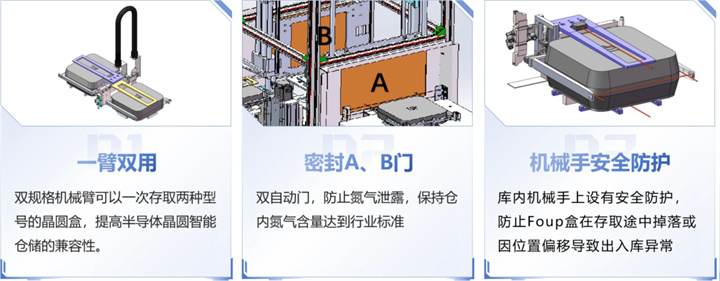




Physical contact detection
1. Mechanical micro switch
Advantages: Simple structure and low cost.
Disadvantage: Mechanical components are prone to wear and tear, which may lead to misjudgment.
Application scenario: Suitable for situations that require simple and reliable solutions, but not suitable for situations that require high precision or long-term stability.
2. Pressure sensor
Working principle: Multiple pressure sensors are distributed on the load-bearing surface of the loadport. When Foup is placed on top, pressure is applied to these sensors, and the presence of Foup is determined by detecting changes and distribution patterns in pressure.
Advantages: Compared to mechanical switches, it is more durable and can provide more information about Foup status.
Disadvantages: High cost, requiring precise calibration.
Application scenario: Suitable for applications that require high-precision detection.
Optical inspection
1. Photoelectric sensor
Working principle: Use photoelectric sensors to emit light beams and receive reflected light. The presence of Foup can alter the intensity or path of reflected light, thereby being captured by sensors.
Advantages: Non contact detection, reducing mechanical wear.
Disadvantage: May be affected by environmental light interference, requiring optimized design to improve reliability.
Application scenario: Suitable for environments with high cleanliness requirements.
2. Visual inspection system
Working principle: Images are captured by cameras installed near the loadport, and Foup features in the images are analyzed using image processing and machine learning techniques.
Advantages: It can identify the specific type of Foup and provide richer information.
Disadvantages: High complexity and relatively high cost.
Application scenario: Suitable for situations that require high automation and intelligent management.
Electrical characteristic testing
1. Capacitive detection
Working principle: Install capacitive sensors on the surface of the loadport, and the presence of Foup will change the capacitance value.
Advantages: contactless detection, fast response speed.
Disadvantage: It is greatly influenced by the surrounding environment.
Application scenario: Suitable for situations with certain requirements for response speed.
2. Inductive detection
Working principle: Determine the presence of Foup by detecting changes in inductance. The metal components contained in Foup can affect the magnetic field of the inductor coil.
Advantages: It is also a non-contact detection method, which is particularly effective for Foup made of metal materials.
Disadvantage: High cost.
Application scenario: Especially suitable for situations where metal material Foup needs to be detected.
Radio Frequency Identification (RFID)
Working principle: Install RFID tags on Foup, and there is an RFID reader at the loadport. When Foup is placed on the loadport, the reader can read the information on the tag to confirm the existence of Foup.
Advantages: Not only can it detect the presence of Foup, but it can also obtain more relevant information such as number, type, etc.
Disadvantage: Relatively high cost.
Application scenario: Suitable for situations that require detailed management and tracking of Foup.

Product Introduction
i-Stock Semi-Foup Stocker, Breaking through technological barriers, creating industry-leading wafer storage equipment, equipped with dual specification robotic arms that can access two types of wafer boxes at once, improving the compatibility of intelligent semiconductor wafer storage. Expansion and integration of AMR/OHT loading and unloading can be achieved both inside and outside the warehouse, making it convenient and efficient to create an intelligent and visual semiconductor wafer storage device.
Connect the material flow and information flow between different process flows and software information, achieve automatic transfer or loading and unloading of wafer materials in various workshops and machines, and solve the problems of low efficiency and low product defect rate caused by manual operations. Empowering semiconductor wafer warehouses and storage processes with equipment, intelligence, and unmanned technology, improving operational efficiency, reducing inventory, achieving the highest value of materials, standardizing management, and reducing enterprise operating costs is our responsibility.
Equipment parameters

Equipment advantages
One arm dual use: flexible adaptation to different sizes of crystal round boxes, achieving diversified production needs.
Intelligent gripping: Combining visual recognition and motion planning to ensure the accuracy and stability of gripping actions.
Efficient production: Improve production efficiency, reduce manual operations, lower error rates, and achieve intelligent production management.
Precise operation: Through an intelligent warehousing system, precise wafer picking and processing are achieved to improve production quality.
Cost saving: Reduce labor costs, minimize operational errors, improve production efficiency, and bring long-term cost savings.





